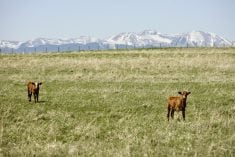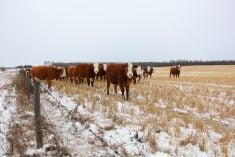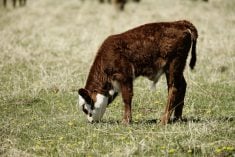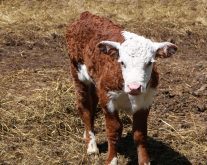Wanda Snobolen’s passion for her Charolais purebreds shines through when she talks about the care she takes when they’re calving.
“When you’re calving and it’s -20 degrees out there, you have to get them dry — that is key,” she says. Depending on how cold it is, she brings the calves into a heated workshop where she can get them dry, and/or puts them in calf coats to conserve body heat.
Every winter, Snobolen’s herd produces about 100 calves. At her farm in Ripley, Ont., she and her family also have 5,000 acres of land in corn, wheat, beans, hay and pasture. She grew up on a beef farm and has raised cattle since she was a 12-year-old in 4-H.
Read Also

Canadian Beef Check-Off Agency reports on investments and activities
The check-off agency’s work behind the scenes is what ensures cattle check-off dollars are invested wisely, accounted for transparently and deliver measurable value back to producers and importers.
“Every year, I’d get a Charolais heifer for 4-H, and that’s how I got a herd of Charolais cows,” she says adding that they’ve owned the current farm since 2000.
About 80 per cent of her calves are born in January, which is earlier than on most Ontario operations because the bulls she sells must be big enough to breed cows the next season.
“Once we get into March and April, we also get busy with the cash crops,” she says.
The farm is located about five miles from Lake Huron, where it can be bitterly cold, especially when the wind is up and the snow is flying. That’s why her calving barn is a 50-foot by 180-foot pole structure that is open to the east with tarps that can be rolled down. On the west side, turkey curtains — heavy, plastic curtains that hang vertically — allow for ventilation.
“It’s cold, but as long as we can keep them out of the wind, it’s usually okay,” she says.
“We can hold up to 12 to 15 calving pairs in pens if we need to,” she says, adding that most of the cows calve in a big open area and are then brought into calving pens.
She uses lots of fresh straw for bedding, which lasts through six weeks of calving, after which time the barn is cleaned out. There are four permanent calving pens on one side of the structure and portable panels can split the rest of the space for whatever she needs. A calf-creep pen lets the calves feed without having to compete with the adult cows.

Feed appropriately
“The vast majority of Ontario beef producers calve their cows in the spring,” says James Byrne, a provincial beef specialist with the Ontario Ministry of Agriculture, Food and Rural Affairs. He notes that, given the size of the province, spring can come in March in the southwest or as late as June in the north. Byrne’s advice for winter calving indoors is to time it as closely as possible to spring so the pairs can be put on pasture.
He also recommends body condition scoring the animals well before they calve, as they’re being brought into housing for the winter.
“Divide the cows into those that have good scores and those that have not-so-good scores,” he says. The two groups should get two different feeding regimes, with higher-quality forage going to those that need help, and lower quality being fed to the healthier animals. The idea is that, by the time they calve, they’re all going to have good body condition scores, which he says is right around the 2.5 mark.
“With that score, you’ll have fewer calving difficulties and deaths, the calves will be healthier, the cows will be able to feed their calves, and the post-partum interval will be shortened so they can be bred again sooner,” he says.
To keep on top of cow health, he says it’s a good idea to go back and repeat the process later in the winter, separating the ones that aren’t performing as well to boost their feeding programs. He says that heifers should be checked because they’re still growing while they’re pregnant and may require a bit of grain along with the forage to keep their energy levels up.
Snobolen says that she feeds the heifers separately from the cows, both before and after calving, so they don’t have to compete.
“They’re still growing, and we want to get them bred back in the first cycle, so they have to get all the nutrition they need,” she says.
She limit-feeds both heifers and cows before calving and full-feeds after.
“We’ll feed first-cut dry hay, which is an alfalfa-timothy mix and then after calving, we’ll feed wrapped second cut and wrapped third cut along with some first-cut dry hay,” she says, adding that she wants to improve the body condition, so they’ll come back into heat and be ready for breeding.

Post-partum, she also feeds free-choice minerals, which works well. Selenium and vitamin E are important components and the selenium supplement is a natural mineral that can be stored in the cow’s body until it’s needed.
Preventive medicine
Both Byrne and Snobolen say that a good vaccination program should be worked out with a veterinarian. Byrne says that program could reflect both how the farmer operates and the kinds of diseases that are prevalent where the farm is located.
“We scour-guard the cows and vaccinate calves when they’re four to six weeks old with an inter-nasal vaccine to prevent things like pneumonia,” Snobolen says, adding that they try to vaccinate before the calves are eight weeks old, which is when passive immunity from their mothers runs out.
Byrne says farmers need to make sure that the calves are suckling and can get enough colostrum as soon as possible — preferably in the first four to six hours — so they can absorb the immunoglobulins that will help prevent disease.
As at the Snobolen farm, Byrne says calving cows need adequate space in pens with good ventilation, no drafts, lots of bedding and good access to water and feed.
Avoiding problems
Snobolen has two pan-tilt-zoom cameras which are positioned so she can read an ear tag on a cow at any point along the 180-foot barn.
Snobolen has two pan-tilt-zoom cameras which are positioned so she can read an ear tag on a cow at any point along the 180-foot barn.
“It’s so nice to be able to zoom in, find out if the calf’s feet are upside down and coming backwards, and get out there to help,” she says. Otherwise, if the birth is going along well, she lets nature take its course.
“With the cameras, I can watch from the couch and not disturb them,” she says.
Most of the time, if there is a problem, Snobolen says her cows are quiet and used to her, so she can get a rope and help right where the cow is calving. If a cow gets into more trouble during calving, she has self-locking head gates to keep both animals and humans safe.
Byrne cautions that heifers should be more closely monitored, given that they are calving for the first time.
The optimal time for re-breeding cows is between 60 and 90 days after calving, Byrne adds.
“To be productive, you want your cow to calve every year. And to be profitable, you want calving time for the herd to be within six to eight weeks,” he says. That way, all the calves will be around the same age and weight, which tends to attract higher prices.
For more on body condition scoring, visit the ‘Body Scoring’ page at the Beef Cattle Research Council website.
















